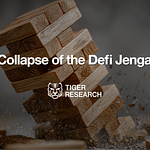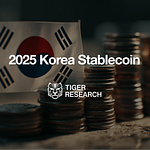This report was written by Tiger Research, analyzing how Korea's June 3rd presidential election will create four major changes in the global crypto market.
TL;DR
South Korea as a Core Web3 Hub: With $5.4 billion in daily trading volume and 9.7 million active users, South Korea ranks as the third-largest crypto market after the U.S. and China. It serves as a key benchmark for global projects expanding into Asia.
Tax Acceleration May Depress Volumes: Although crypto tax implementation is currently delayed until 2027, the new administration is likely to bring it forward. Drawing from international precedents, trading volume could decline by over 20%.
ETF Approval Likely; Other Reforms to Face Delays: All major candidates support introducing bitcoin spot ETFs, increasing the likelihood of early adoption. In contrast, regulatory changes around KRW stablecoins and the “one exchange–one bank” policy are expected to be longer-term agenda items.
1. Is South Korea’s June Presidential Election Only a Local Concern?
South Korea is set to hold its presidential election on June 3. While it may appear to be a local political event, its implications extend beyond national borders due to the country’s influence on the global crypto market.
South Korea is widely regarded as the third most critical market for global Web3 projects, following the United States and China. This position is not simply the result of marketing strategy. According to a 2024 report from the Financial Services Commission, South Korea’s daily crypto trading volume reaches KRW 7.3 trillion (approximately $5.4 billion), with over 20 million registered accounts and 9.7 million active users.
Investor behavior further reinforces this status. Korean users consistently show strong interest in altcoins beyond Bitcoin and Ethereum. On-chain activity is also robust, making South Korea a valuable indicator of global market reception for new projects.
For many global projects, establishing a presence in South Korea has become a strategic entry point into the broader Asian market. This gives particular weight to the upcoming election, as key campaign issues now include crypto taxation, KRW stablecoin regulations, and crypto ETF approval.
These developments are not limited to domestic stakeholders. Global investors and project operators must also monitor the outcome. Both regulatory tightening and easing remain plausible, and projects with a large Korean user base may be especially sensitive to the policy direction set by the next administration.
2. What Will Change After the South Korean Presidential Election?
2.1. End of Crypto Tax Deferral
Under the Financial Services Commission’s roadmap for corporate participation in the crypto asset market, corporate entities are being granted phased access to crypto markets. This gradual market opening inevitably calls for a corresponding overhaul of the tax framework.
Currently, South Korea's virtual asset taxation is deferred until 2027. The original plan was to impose a 20% tax on annual gains exceeding approximately USD 1,850 starting January 2025. However, the implementation was postponed by two years.
A growing point of contention is that both individuals and corporations currently benefit from the tax deferral despite generating income from crypto transactions. According to the FSC roadmap, starting in the second half of 2025, listed companies and registered professional investment firms will be allowed to invest in virtual assets through corporate accounts.
Given this shift, it is unlikely that the deferral will be extended again for both individuals and corporations. The government may instead pursue legislative amendments to repeal the current deferral and bring forward the implementation of taxation.
Political positions on the tax deferral have historically differed across parties. The Democratic Party initially advocated for raising the exemption threshold rather than delaying the tax, although it ultimately supported the deferral. Depending on the election outcome, the policy may shift back toward increasing the deduction limit instead of maintaining the deferral.
If taxation is implemented, a significant decline in domestic exchange volume is likely—consistent with international precedents. In 2022, India imposed a 30% tax on crypto gains and introduced a 1% withholding tax on all transactions. This led to trading volume declines of 10% to 70% on major platforms such as WazirX and CoinDCX. Similarly, following the introduction of high tax rates in 2023, Indonesia saw a year-over-year volume drop of approximately 60%.
While South Korea’s proposed tax is less aggressive, these examples suggest that local exchange volume could fall by more than 20%, accompanied by a potential shift of capital to offshore platforms.
2.2. Introduction of Crypto ETFs
Lee Jae-myung (Democratic Party): On May 6, Lee announced via Facebook his support for spot crypto ETFs as part of a broader initiative to support youth asset formation. He also proposed lowering investment fees to improve accessibility.
Kim Moon-soo (People’s Power): On April 27, he expressed openness to allowing public institutions to invest in the crypto market. His ten core policy pledges include introducing a spot crypto ETF under the banner of “middle-class wealth expansion.”
Lee Jun-seok (Reform Party): On May 20, through his YouTube channel, Lee proposed that the government hold Bitcoin as a national strategic reserve through vehicles such as ETFs.
The introduction of spot crypto ETFs is the only policy proposal with cross-party consensus among leading candidates, making it one of the most likely short-term outcomes. Policy discussions are expected to begin in earnest shortly after the election.
If spot ETFs are introduced, they will naturally trigger fee competition with existing exchanges that facilitate spot Bitcoin trading. This would foster healthier market dynamics and improve overall service quality. For investors, particularly those with smaller portfolios, lower fees could reduce entry barriers and enhance accessibility.
In the longer term, the launch of spot ETFs could serve as a catalyst for further financial innovation. It may pave the way for new products that integrate cryptocurrencies with traditional finance, such as derivatives, index funds, and other hybrid investment vehicles.
2.3. Revisiting the 'One Exchange–One Bank' Model
To manage anti-money laundering (AML) risks in the crypto sector, South Korea has maintained an implicit “one exchange–one bank” principle. Under this model, each licensed crypto exchange is permitted to partner with only a single commercial bank for issuing real-name verified deposit accounts. For example, Upbit works exclusively with K-Bank, while Bithumb is linked to KB Kookmin Bank.
This framework stands in contrast to jurisdictions like the United States, where platforms such as Coinbase offer integration with multiple financial services, including Apple Pay, Google Pay, and various banking institutions.
The debate over dismantling the "one exchange–one bank" principle gained traction after Woori Bank CEO Jeong Jin-wan raised the issue during a policy discussion with lawmakers from the People Power Party. He argued that the current structure poses systemic risks, restricts consumer choice, and imposes unnecessary constraints on corporate clients. Jeong called for a shift toward a “one exchange–multiple banks” model.
As the presidential race unfolded, political parties began to take positions. On April 28, the People Power Party included the abolition of the one exchange–one bank rule in its "Seven Key Digital Asset Pledges." The Democratic Party also appeared to be reviewing the matter internally. However, caution has since emerged within the Democratic Party, making it unclear whether the issue will be reflected in official campaign pledges. Financial regulators have likewise maintained a cautious stance, indicating that any change will likely be subject to long-term deliberation.
While regulatory prudence is warranted, maintaining the current model based on concerns over market concentration and AML risks may require reconsideration. The argument that the rule prevents market dominance is increasingly unconvincing, given that Upbit and Bithumb already control approximately 97% of the domestic market. Allowing multiple banking partnerships could enhance competition by enabling exchanges to serve a broader user base. This may lead to lower fees and more innovative services for retail and institutional users alike.
Concerns over AML risks also merit a more nuanced evaluation. In practice, the greater risks arise during outbound transfers to overseas exchanges. Since the implementation of the Travel Rule and improvements in compliance infrastructure, South Korea now operates under stricter international monitoring standards. Given this context, the systemic risk posed by allowing multiple banking relationships appears overstated.
2.4. KRW-Backed Stablecoins
Historically, South Korea has prioritized the development of a central bank digital currency (CBDC) over stablecoins. The Bank of Korea is currently conducting a pilot program—Project Han-Gang—to test CBDC-based payment and settlement systems. However, as global momentum shifts toward stablecoins, domestic demand for a KRW-backed stablecoin is gaining traction.
Lee Jae-myung:
Lee Jun-seok:
May 18: Questioned the feasibility of Lee Jae-myung's proposal, citing the lack of clarity on anti-money laundering measures in stablecoin issuance.
Kim Moon-soo:
April 28: Included a regulatory framework for stablecoins in his “Seven Key Digital Asset Pledges.”
The first presidential debate on May 18 brought stablecoins into mainstream political discourse, primarily through exchanges between Lee Jae-myung and Lee Jun-seok. While the discussion highlighted directional support, it also underscored the lack of detailed policy frameworks—particularly on risk mitigation and compliance.
At this stage, the proposal for a KRW-backed stablecoin remains aspirational rather than actionable. Immediate post-election implementation is unlikely. However, considering regional trends—particularly in Singapore and Hong Kong, where authorities are actively developing stablecoins tied to local currencies—South Korea may face increasing pressure to follow suit in order to remain competitive as a financial hub.
Any meaningful progress will require a foundational legal and regulatory framework. Key issues include identifying eligible issuers, ensuring collateral transparency, establishing AML protocols, and defining the relationship between stablecoins and the CBDC initiative. Given the complexity of these matters, policy developments are expected to follow a phased, medium- to long-term approach rather than rapid change after the election.
3. Gradual but Inevitable: Changes on the Horizon
While the discussed policy shifts are significant for the industry, they are unlikely to materialize in the immediate term. Among the major presidential candidates, only Kim Moon-soo has included Web3-related measures in his top ten campaign pledges. This suggests that, despite industry relevance, Web3 issues are not currently prioritized in the broader policy agenda.
As a result, regulatory changes are expected to progress gradually, with discussions likely occurring in parallel to more urgent policy items. However, the trajectory remains clear: transformation is inevitable.
The eventual implementation of crypto taxation, as previously discussed, is unavoidable. In addition, legislative discussions around Security Token Offerings (STOs) are expected to resume. For investors and market participants, these shifts should not be underestimated. Stakeholders must begin preparing for a policy environment that will become increasingly formalized and compliance-driven.
🐯 More from Tiger Research
Read more reports related to this research.Disclaimer
This report has been prepared based on materials believed to be reliable. However, we do not expressly or impliedly warrant the accuracy, completeness, and suitability of the information. We disclaim any liability for any losses arising from the use of this report or its contents. The conclusions and recommendations in this report are based on information available at the time of preparation and are subject to change without notice. All projects, estimates, forecasts, objectives, opinions, and views expressed in this report are subject to change without notice and may differ from or be contrary to the opinions of others or other organizations.
This document is for informational purposes only and should not be considered legal, business, investment, or tax advice. Any references to securities or digital assets are for illustrative purposes only and do not constitute an investment recommendation or an offer to provide investment advisory services. This material is not directed at investors or potential investors.
Terms of Usage
Tiger Research allows the fair use of its reports. ‘Fair use’ is a principle that broadly permits the use of specific content for public interest purposes, as long as it doesn't harm the commercial value of the material. If the use aligns with the purpose of fair use, the reports can be utilized without prior permission. However, when citing Tiger Research's reports, it is mandatory to 1) clearly state 'Tiger Research' as the source, 2) include the Tiger Research logo. If the material is to be restructured and published, separate negotiations are required. Unauthorized use of the reports may result in legal action.














